
Opisthacanthus rugiceps is a species of African scorpion.

The Brandberg is Namibia's highest mountain.
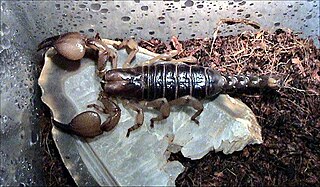
Opistophthalmus is a genus of scorpions known commonly as burrowing scorpions, tricolored scorpions, serkets, or hissing scorpions. They are found predominantly in southern Africa. They are known for making deep and elaborate burrows.
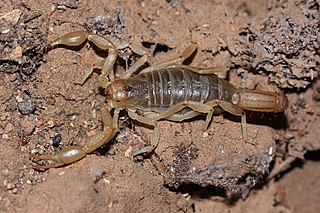
Paravaejovis spinigerus, commonly known as the stripe-tailed scorpion or devil scorpion, is a species of scorpion in the family Vaejovidae. It is found in the south-western United States and north-western Mexico.

Hadogenes bicolor is a species of scorpion endemic to South Africa. This species is often confused with H. troglodytes.

The Buthidae are the largest family of scorpions, containing about 100 genera and 1339 species as of 2022. A few very large genera are known, but a high number of species-poor or monotypic ones also exist. New taxa are being described at a rate of several new species per year. They have a [cosmopolitan] distribution throughout tropical and subtropical environments worldwide. Together with four other families, the Buthidae make up the superfamily Buthoidea. The family was established by Carl Ludwig Koch in 1837.
Hemiscorpius is the sole genus of the scorpion family Hemiscorpiidae, with about 16 described species. Before Hemiscorpiidae, the term used for the family was Ischnuridae, which had to be changed due to a naming conflict with the damselfly family of the same name. They at one point also held the name Liochelidae.

Centruroides is a genus of scorpions of the family Buthidae. Several North American species are known by the common vernacular name bark scorpion. Numerous species are extensively found throughout the southern United States, Mexico, Central America, the Antilles and northern South America. Some are known for their interesting patterning or large size ; most if not all fluoresce strongly under ultraviolet illumination, except after moulting. They contain several highly venomous species, and fatalities are known to occur. The venom of the Mexican scorpion Centruroides limpidus limpidus contains the neurotoxins Cll1 and Cll2.
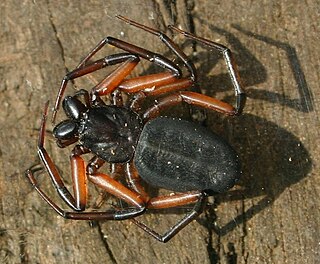
Platyoides is a genus of spiders belonging to the family Trochanteriidae. Its members are known as scorpion spiders and are found in sub-Saharan Africa and its islands, Madagascar, Réunion, Aldabra and the Canary Islands.

Hadogenes troglodytes is a species of scorpion from southern Africa. It is commonly known as the flat rock scorpion and commonly sold on the exotic pet market. It was once regarded as having the longest recorded body length of any scorpion, reaching up to 20 cm; however Heterometrus swammerdami currently holds the record for being the world's largest scorpion at 9 inches (23 cm) in length. May be confused with Hadogenes bicolor.

Hubbardiidae is a family of arachnids, superficially resembling spiders. It is the larger of the two extant families of the order, Schizomida, and is divided into two subfamilies. The family is based on the description published by Orator F. Cook in 1899, and was previously named as Schizomidae. The American Arachnological Society assigns the common name hubbardiid shorttailed whipscorpion to members of this family
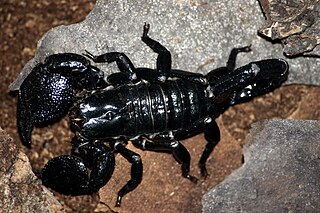
Pandinus is a genus of large scorpions belonging to the family Scorpionidae. It contains one of the most popular pet scorpions, the emperor scorpion . The genus is distributed across tropical Africa.

William Frederick Purcell was an English-born South African arachnologist and zoologist. He is regarded as being the founder of modern araneology in South Africa.
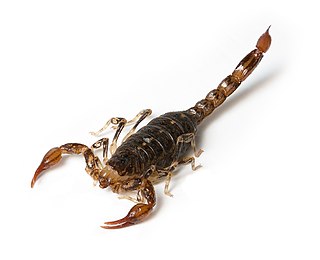
The Bothriuridae are a family of scorpions, comprising 151 species in 16 genera.

Uroplectes is a genus of scorpions in the family Buthidae. They are known commonly as the lesser thick-tailed scorpions. There are about 40 species distributed in the Afrotropical realm. They are most diverse in South Africa.

Parabuthus, commonly known as the thick-tailed scorpion, is a genus of large and highly venomous Afrotropical scorpions, that show a preference for areas of low rainfall. Their stings are medically important and human fatalities have been recorded.

Hadogenes soutpansbergensis is a scorpion species endemic to South Africa in the bicolor group of the genus Hadogenes. It is named after the Soutpansberg mountain range where it was found.

Hadogenes gracilis commonly known as the fine rock scorpion is a species of scorpion in the family Hormuridae. This species is quite small when compared against other members of Hadogenes.
Hadogenes gunningi, commonly known as Gunning's rock scorpion or Rotsskerpioene in afrikaans, is a small species of scorpion of the genus Hadogenes. It is found in southern Africa, particularly the province of Gauteng. The venom of the members of the genus Hadogenes has been compared to a nettle sting and will often results in an itch for roughly two minutes.

















